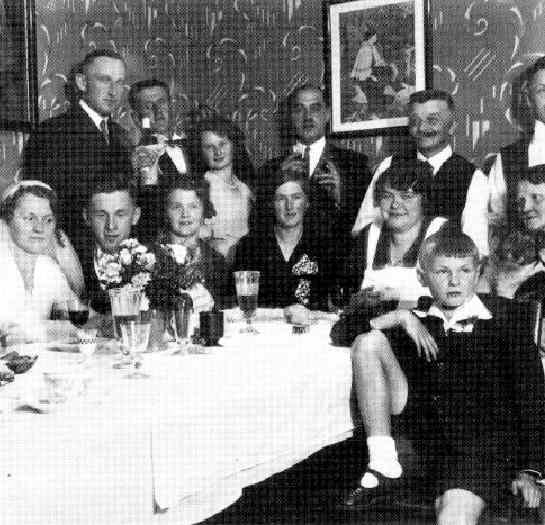
German Boys' Garments: Regional Differences--Sudetenland

Figure 1.--This Sudeten German boy is pictured in 1933 with a wedding clebration in the 1930s. Notice the open necked shirt even for a wedding. He wears sandals and white ankle socks, or have kneesocks fllen down, with a short pants suits. He looks to be about 11-years old.
|
Sudeten German boys appear to have dressed much like German and Austrian boys. Styles also appear to have been similar to Czech boys which also appear to have been similar to German and Austrian boys. We note that sailor suits were popular in the early 20th century as were wide-brimmed sailor hats while the Sudetenland was part of the Austro-Hungarian Empire. Kneepants gave way to short pants in the 1920s. Long stockings were worn during the winter. Some boys wore sandals. Some smocks were worn, but we do not know how prevalent this was or what the fashion influence was. Most but not all boys appear to have worn short pants in the first half of the 20th century, even some quite old boys. Kneesocks were common, but many boys wore long stockings during the winter. We note younger boys wearing rompers, a rather French looking style. White kneesocks and long stockings seem common, but more for the girls than boys.
Styles
Sudeten German boys appear to have dressed much like German and Austrian boys. Styles also appear to have been similar to Czech boys which also appear to have been similar to German and Austrian boys.
Specific Garments
We have developed the following information on garments worn by Sudeten boys.
Rompers
We note younger boys wearing rompers, a rather French looking style. German boys also wore rompers, but mostly in the todler years.
Some smocks were worn, but we do not know how prevalent this was or what the fashion influence was. German boys did not commonly wear smocks. We have noted some in the early 20th century, but by the NAZI era (1933-45) we rarely see them. We have one image of a family where all the children (two girls and a boy are dressed in identical smocks). The photograph is a family portrait at home. We do not know if this was just for home wear or if the children played in these smocks. They look rather dressy for playwear. We doubt, however, if the boy went to school in this smock. Other photographs of the family show the boy wearing short pants.
Sailor Suits
We note that sailor suits were popular in the early 20th century as were wide-brimmed sailor hats while the Sudetenland was part of the Austro-Hungarian Empire.
Pants
Kneepants gave way to short pants in the 1920s. Long stockings were worn during the winter. Most but not all boys appear to have worn short pants in the first half of the 20th century, even some quite old boys.
Hosiery
Kneesocks were common, but many boys wore long stockings during the winter. White kneesocks and long stockings seem common, but more for the girls than boys. Some boys in the 1930s were wearing white socks for formal dressup occasions.
Foowear
Some boys wore sandals.
Christopher Wagner

Navigate the Boys' Historical Clothing German pages:
[Return to the Main Sudeten page]
[Return to the Main Czecheslovakian page]
[German choirs]
[German movies]
[German school uniforms]
[German royalty]
[German youth groups]
[German sailor suits]
[Lederhosen]
[Ethnic]
[Tights]
[Long stockings]
Navigate the Boys' Historical Clothing Web Site:
[Introduction]
[Activities]
[Bibliographies]
[Biographies]
[Chronology]
[Clothing styles]
[Countries]
[Contributions]
[FAQs]
[German glossaries]
[Satellite sites]
[Boys' Clothing Home]
Created: January 31, 2002
Last updated: January 31, 2002



